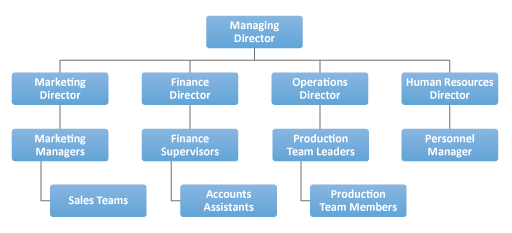1 What is networking?
The Concise Oxford English Dictionary (2009, p. 961) defines a ‘network’ as an ‘arrangement of intersecting horizontal and vertical lines.’ This might not immediately seem relevant to networks of people but actually it helps with visualising how people in a network connect up, because the dictionary goes on to suggest that a network can also be ‘a group or system of interconnected people and things’. Figure 1 is an example of what a network of people might look like. It shows clearly the direct connections from one person to another. However, it also shows the same people are connected indirectly, via other contacts.
Alternatively, Figure 2 is an example of a typical organisation chart for a business.
There are vertical lines between people, representing who is more senior and who reports to whom. As well as this vertical arrangement, there are also clear horizontal arrangements for the roles. These indicate which departments are equal to but different from each other. Effectively, the organisation chart shows how the ‘system’, which is the business in this case, is interconnected and meant to function.
However, most people who have worked in organisations know that people do not always communicate in the vertical and horizontal ways which the chart suggests. People talk to the people they know. So a more informal network will exist within any organisation and it will look more like the interconnected web shown in Figure 1.
This is because networks are groups of people with a common interest, one which is not dependent on tasks or work objectives. For instance, your organisation might have a running club, where all the members are interested in running but wouldn’t necessarily work with each other directly.
In your personal life, you might belong to an online network of rail enthusiasts, or you perhaps participate in a walking group in which walk leadership is provided by anyone knowing the route.
Networks bring together people with a common interest, they are largely outside formal structures, and any hierarchy which might exist is based on the usefulness of a person to the network.
Now you have a picture of a network, let’s move onto to thinking about networking in the next section.


